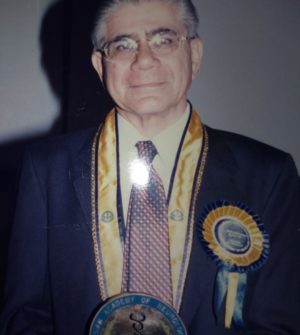EVOLUTION OF THE INSTITUTE OF NEUROLOGY
________
AT CHENNAI:
History of Neurosciences in India was underwritten by the Institute of Neurology, Chennai. What started in 1950, as Department of Surgical Neurology under the Late Dr.B.Ramamurthy fondly known as Prof. BRM, progressed to become a full fledged.
Neuro Sciences Institute, with incorporation of Neurology, Neurophysiology, Neuropsychology with some elementary Neurochemistry. This was achieved by joining of Prof.G.Arjundas as the first Neurologist. He was followed by Prof.K.Jaganathan (Neurology), Prof.Krishamurthi Srinivas (Child Neurology), Prof.K.Srinivasan(Neurology), Prof.Zaheer Ahmed Sayeed (Neurology and Neurophysiology) and later by Prof.C.U.Velumurugendran (Neurology). Prof.Sarasa Bharathi (Neuropathalogy), and Prof.Virudagirinathan (Neuropsychology) along with Prof.Valmikinathan (Neurochemistry) completed the team.

AT MADURAI:
Early on Dr.K.Srinivasan took over the reigns of Neurology at Rajaji Medical College Madurai, preceded by Dr. M.Natrajan who has the honor of being the first person in Madurai to handle Surgical Neurology.
STEREOTAXY AT MIN:
Surgical Neurology along with Late Professor BRM was complimented with the addition of the Late Prof.V.Balasubramanian (Stereotaxic Surgery) joined much later by the late Professor S.Kalyanaraman, the late Professor.Dr.T.S.Kanaka and the late Professor Narayanan.
By 1975 all sub-specialties of Neurology were in place along with different modalities of surgical neurology. The interaction between Neurophysiology and surgical neurology gave birth to stereotaxic treatment of seizures, movement disorders, and functional neurosurgery of the Behavioral Brain, which remained the cutting edge for the institute for a long time.
CLAPPING TOGETHER:
This interaction between Neurology-Neurophysiology and surgical neurology for purposes of posterity could be characterized by the following:
During depth recordings for isolation of an epileptiform focus stimulation of the Amygdala Complex, through depth electrode, produced short timed ventilatory arrest on the operating table (the patient was in receipt of O2 and anesthetic). The occurrence of this respiratory arrest was considered as a certifying fact that, recording and stimulating electrode was in the Amygdala complex.

Contrast this with the present day finding of respiratory arrest in epileptic patients with SUDEP, which shows involvement of the Limbic system including the Amygdala by Functional MRI, suggesting prolonged respiratory arrest as the possible cause of death in SUDEP and thereby reinforcing the concept of adequate ventilation post ictally in a seizure as well as status epilepticus.
NEUROPHYSIOLOGY – PINOEERING WORK:
The institute of Neurology at one time published the largest collection of Anterior Horn Cell-Motor system disease inclusive of SMA (We are looking at treatment modality for both now).

Amygdalar ablation as a therapeutic measure for temporal lobe seizures with concurrent, intraoperative monitoring precipitated sufficient interest and enquiry but did not achieve criticality due to irregular and unsustained preop and postop follow up measures.
Similar paradigms were applicable for ablation of Globus pallidum and subthalamic nucleus and other thalamic nuclei. However stereotactic ablation were used extensively for helping patients with temporal lobe epilepsy and movement disorders. Wax and radiofrequency were instruments of ablation. However, now Ultra sound is used on the same anatomical structures as the ablating material.
The deep bonds of relationship between Neurologists and surgical Neurologists materialized in simultaneous depth recordings of Central median nuclei of the thalamus, the red nuclei of the mid brain and the cortical mantle (introperative EEG). Peri aqueductal gray matter was the target in a patient with Subacute Sclerosing panencephalitis. The findings confirmed the periodic complexes of SSPE.
Tuberculosis of the nervous system kept all departments busy enough to label all ring lesions as tuberculomas which, later in some proportions were revised with the diagnosis of cysticercal disease.
In 1980, with the advent of CT Scan followed by the MRI and the operating microscope firmly stepping into the operating room, history was made!!
DIVERGENT PATHS:
To date there have been many heads of the Institute of Neurology. Of these few were neurologists and few were surgical neurologists. Some time before the unison of departments of medical and surgical neurology, gave way to independent directorates.
One could argue the necessity of such division, it was fun to be together.
Some day one hopes the Institute is endowed by those concerned with high stepping independent departments of Neurochemistry and genetics. I doubt if this will happen in my life time !!!!!!!!
ZAS, Oct 2019
